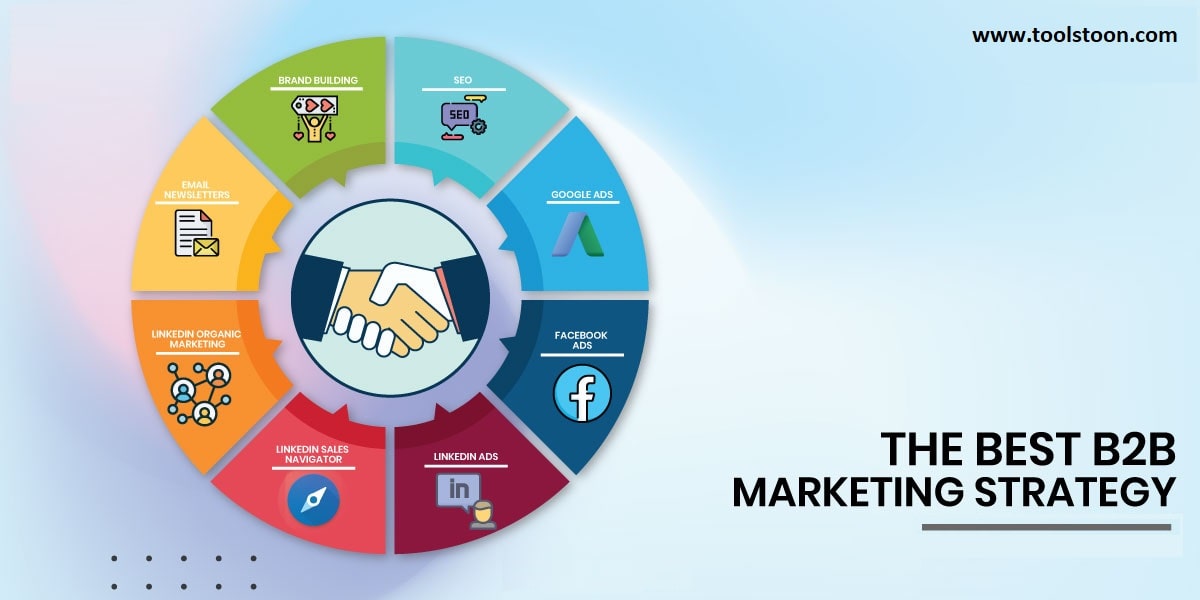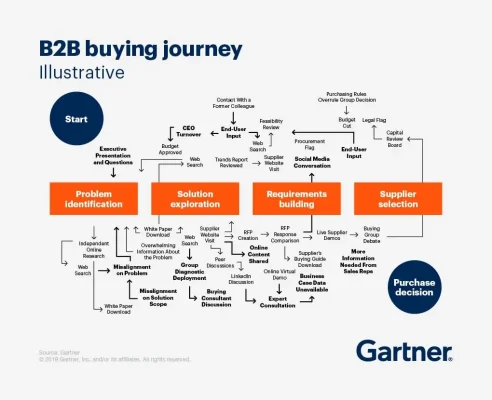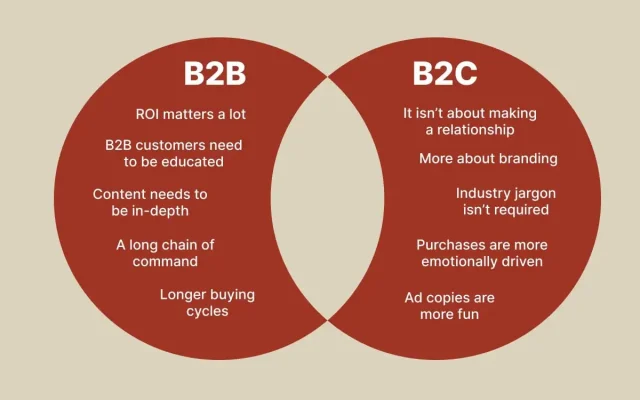No products in the cart.
SEO
Optimizing Your B2B Strategy: 9 Expert Tips to Align SEO with the Buyer’s Journey
Last Updated on December 26, 2023 by Jeff Vardy
A B2B buyer’s buying journey differs significantly from a B2C buyer’s. Any B2B organization can use SEO as a powerful acquisition channel with the right strategy.
Here are the top tips for ensuring your SEO success is set up for success at every stage of the B2B buyer’s journey.
An understanding of the B2B buyer’s journey
We can still view the buyer’s journey through the traditional purchase funnel lens of awareness, consideration, and decision.
In recent years, B2B purchasers have increasingly explored solutions and conducted research well into the purchasing process.
Stage of Awareness
- This is the beginning of the buyer’s journey in B2B.
- Typically, potential customers are just beginning to recognize a problem or need and are seeking informational content to find answers.
- You should target broad, informational keywords aligned with your target audience’s general inquiries.
Consideration stage
- The buyer has clearly defined their problem or need and is now exploring different solutions, products, or services.
- During this period, they compare options, read reviews, and learn more about each solution.
- By using case studies, reviews, and testimonials, SEO Tools, content should highlight the unique selling points of your products or services.
Stage of decision-making
- All the necessary information is in hand, and the buyer is ready to make a purchase.
- It is characterized by specific, high-intent searches that may include specific product names, pricing information, or implementation details.
- The importance of search engine optimization in capturing high-intent searches and directing them to conversion-optimized pages cannot be overstated.
Traditionally, B2B sales were conducted at conferences, but digital events and communities (like webinars) have replaced them in the post-pandemic era.
Consequently, consumers increasingly rely on content consumption to make purchase decisions, emphasizing the importance of a solid SEO strategy.
Tips for B2B SEO during the Awareness stage
1. Make keyword research your first step.
Understanding your target audience’s needs, search trends, and personas is the first step in developing an effective B2B SEO strategy.
You need to understand the kind of information B2B customers seek before even considering your brand or the solution you offer as you tailor your content marketing and SEO efforts.
Then, conduct keyword research to better understand how your buyer works online searches.
Match your content (e.g., pricing information, product demos, or category explainers) with broad informational keywords within your category.
Now is the time for SEO professionals working for agencies to get to know their clients’ products and industry-specific language.
The intent behind prospective buyers’ searches – whether they want to know, go, do, or buy – is essential to determining what content to provide at each stage of their journey.
2. Know the difference between B2C and B2B.
There are more C-suite stakeholders and a greater focus on ROI and bottom line for B2B purchases than for B2C purchases.
In addition, keyword search volume and qualified leads are generally lower in B2B, highlighting the importance of quality top-of-funnel traffic.
Create relevant content even at this early stage that:
- Describes the efficiency and effectiveness of your product or service.
- Translates easily to decision-makers who are not in the immediate loop.
A blog post, guide, or introductory video can help build visibility and trust at this stage.
Whitepapers and ebooks are other ways to demonstrate your expertise.
3. Provide buyers with content that guides them.
Topic clusters are a great way to move visitors from awareness to consideration when creating and optimizing content.
For B2B businesses, especially those operating in specialized or niche markets, structuring your website information in this way allows you to showcase deep expertise.
By thoroughly covering a topic, you provide valuable information to your audience and increase the likelihood of dominating search engine results pages (SERPs) for a range of related queries, not just isolated keywords.
Let’s take the example of a CRM provider for small businesses.
- With the relatively high volume of “CRM software” and “CRM software small business” keywords, a pillar page called “Comprehensive Guide to CRM for Small and Medium-Sized Businesses” might capture awareness among searchers.
- Following this, links to cluster pages such as “Choosing the Right CRM for Your Small Business: What to Look For” and “Maximizing ROI from CRM: Strategies for SMEs” provide additional insights and product-specific information.
Consideration stage B2B SEO tips
4. Keywords for comparison and evaluation
The next step is to identify potential customers’ keywords to compare products and services. These keywords often include:
- The “comparison”
- “Vs.” or “versus.”
- The “Features”
- The “benefits”
- The “Reviews” section
Develop content that directly addresses comparison queries using keyword research tools to identify the specific phrases your target audience uses during the consideration phase.
An audience close to converting would benefit from comparison guides, blog posts that compare the features of different products or services, and detailed cost-effectiveness analyses.
5. Utilize testimonials and case studies.
When you optimize these case studies with relevant keywords, especially those that your potential customers are likely to use when looking for real-world examples of your products, you’ll be able to demonstrate the effectiveness of your product.
A ROI calculator, for instance, can help develop a business case for stakeholders. This is where you might start incorporating long-tail keywords alongside broader keywords.
Content should be unbiased, informative, and valuable, helping readers make informed decisions based on Google’s E-E-A-T guidelines.
Visitor experience can be conveyed by genuine, verified user reviews, guest posts from subject matter experts, and thought leadership pieces from company executives.
6. Enhance the user and search engine experience on your website.
Each product should have a dedicated landing page optimized for search engines and users.
Page titles, meta descriptions, headers, and content should include targeted keywords, make sense in the context of your site structure, and include clear calls to action (CTAs).
Make it easier for users and search engines to find relevant content by improving the site structure and navigation.
Your content should follow the same structure as your pillars and clusters: as visitors learn more about your offerings, they should be logically guided toward a conversion.
Focus on engagement metrics when evaluating your efforts:
- Time on site.
- Bounce rate.
- Pageviews per session.
B2B marketers often emphasize ” micro-conversions ” more than B2C marketers.
Through SEO, potential customers are directed to different stages of the funnel, where they can download ebooks or view product demos.
Hopefully, these interactions will lead to a long-term, high-value purchase relationship.
Tips for B2B SEO at the Decision Stage
7. Keywords with high intent should be prioritized.
Identify and target your bottom-of-funnel keywords here, focusing on queries that indicate a readiness to buy, including more specific branded terms, product names, and service-specific queries.
Utilize featured snippets, “People also ask,” or knowledge graphs to enhance visibility and provide immediate information.
8. Streamline conversion processes
It is crucial to fine-tune your landing pages to encourage conversions. They should:
- Load quickly.
- Display well on mobile devices.
- Provide all the necessary information at a glance.
Test A/B or CRO options to land on a clean and effective design that focuses on the product and drives conversions.
If the user is prompted to take the next step, whether it’s filling out a form, downloading a trial offer, or making a purchase, the CTA should be clear, compelling, and strategically placed.
9. Provide technical content that is valuable and validating.
Create content that caters to visitors who are making the final decision, as well as those who are trying to validate their purchase. This includes:
- Detailed product comparisons.
- Reviews.
- How-to guides addressing different use cases.
You can be particularly effective here by using third-party reports or reviews that demonstrate how your offering stacks up against your competitors.
Address popular branded queries in particular. By posting your own reviews, comparisons, and product feature guides, you can capture attention (and get ahead of any potentially negative third-party pages) since searchers are likely already deep in the decision stage.
Regularly review your onsite technical information to ensure it is current, accurate, and reflects the current state of your products.
The role of SEO in the B2B buyer’s journey
There is a distinct approach required for each stage of the B2B buyer’s journey – awareness, consideration, and decision – combining traditional SEO techniques with a deep understanding of the B2B purchasing process.
Keeping informed and agile will help you maintain a competitive edge and drive meaningful engagement with your target audience.



